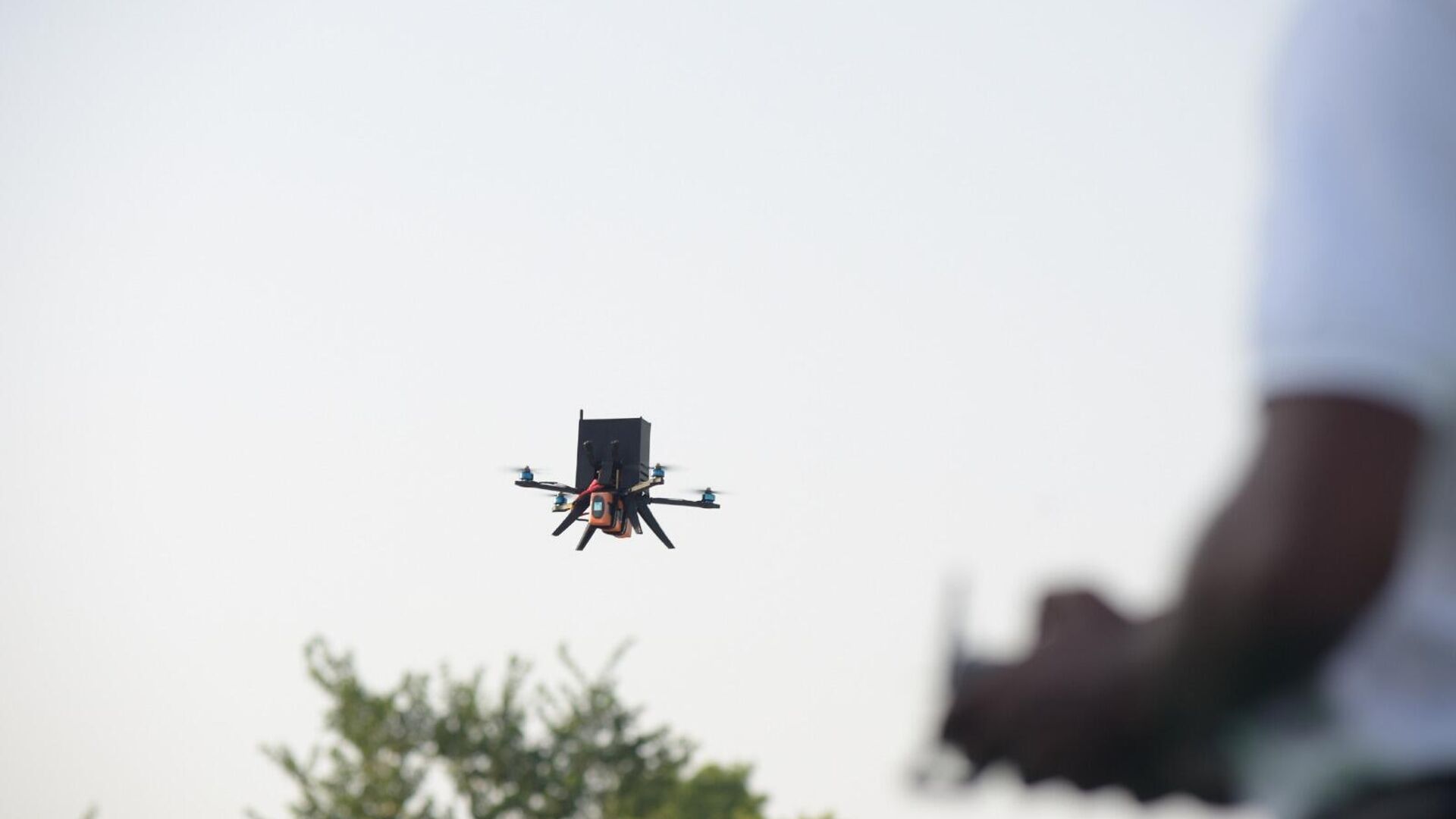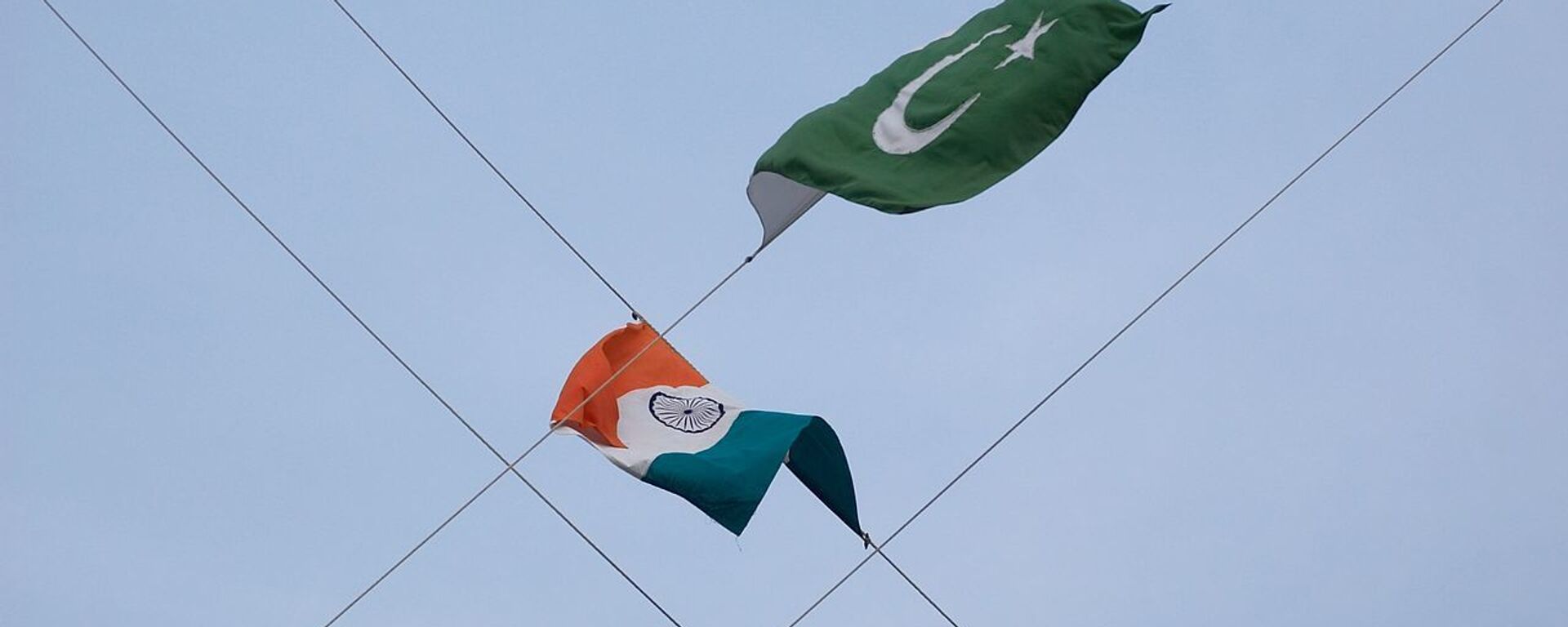https://sputniknews.in/20240509/surge-in-drone-drug-smuggling-from-pakistan-to-india-poses-new-security-challenge-7322275.html
Surge in Drone Drug Smuggling From Pakistan to India Poses New Security Challenge
Surge in Drone Drug Smuggling From Pakistan to India Poses New Security Challenge
Sputnik India
Th illegal drug trade between Pakistan and India has escalated recently, with an alarming rise in the use of drones as a preferred mode of trafficking. 09.05.2024, Sputnik India
2024-05-09T17:44+0530
2024-05-09T17:44+0530
2024-05-10T16:09+0530
pakistan
india
border security force (bsf)
indian coast guard
drug smuggling
drug trafficking
arms trade
drone
https://cdn1.img.sputniknews.in/img/07e7/09/04/4020498_0:84:1600:984_1920x0_80_0_0_9e7bd0036239e0bc7056fecf516ad409.jpg
Indian Border Security Forces (BSF) face an unprecedented drone infiltrating threat at the border with Pakistan.According to a recent report, quoting an official spokesperson of BSF, more than half a dozen drones carrying drugs and weapons have been shot down in just last week alone.Every year about 600 cases of smuggling of drugs and weapons worth millions from Pakistan into India on drones are reported.The Indian border officials said that the growing number of drones coming over from Pakistan using increasingly advanced technology are presenting a significant security risk.These drones — or unmanned aerial vehicles (UAVs) — have been detected as far as 12 kilometres (7.5 miles) inside India’s border, carrying consignments of opium, methamphetamine and heroin.Rising Drone MenaceThe drones used for smuggling vary in size and capabilities, with some being Chinese hexacopters up to 8 feet wide, equipped with high-resolution cameras. Most of the intercepted drones carry opium and heroin, likely originating from Afghanistan with the drugs often concealed in small sacks or even Coca-Cola bottles.In addition to narcotics, some drones have been discovered dropping weapons, including pistols and Chinese-made assault rifles — adding a new dimension to the security challenges faced by India’s border forces.Sputnik India spoke with Khalid Zulfikar, a security analyst and former military officer in Pakistan's Armed Forces, who explained why drones have become a chosen method of drug smuggling across the border.The new drones are constructed from materials that absorb or scatter radar waves, making them less detectable by radar systems.According to the analyst, drones used in drug smuggling across the border are equipped with an autonomous navigation system that can follow pre-set flight paths without continuous corrections by the pilot, which minimizes the need for human control and reduces the chances of detection.Following the recent escalation in smuggling operations, the Indian Border Security Force (BSF) stated that the sophisticated drones can even detect obstacles in their path and adjust their flight trajectory to avoid collisions. This agility allows them to navigate challenging terrain and evade security patrols, making it more difficult for BSF to stop their entry into India.The Changing Landscape of SmugglingTraditionally, smuggling between Pakistan and India involved methods ranging from camels and carrier pigeons to human traffickers and underground pipes. But since the first drone was spotted in the Indian Punjab in 2019, it has become the primary method for drug trafficking from Pakistan.Nevertheless, drones are not the only method to transport drugs between Pakistan and India, as just last week an Indian fishing boat was caught with 173 kg of hashish which was sourced from Pakistan.This was the first case in recent times of Indians having crossed over to Pakistani waters to collect a drug consignment, along with rations and fuel. The total value of the hashish confiscated by the forces is estimated at Rs 60 crore ($7 million).In another shocking case, the Indian Coast Guard intercepted a Pakistani boat in April off the coast of Gujrat, carrying nearly 86 kg of drugs, mostly heroin, worth Rs 600 crore ($70 million).Along with the drugs, 14 crew members from the Pakistani vessel were also detained.Pakistan's Response to Drug TraffickingZulfikar told Sputnik India that the Pakistani government acknowledges the severity of the issue and is taking steps to combat drug trafficking.As drones become more sophisticated, Pakistan needs to enhance its surveillance capabilities and collaborate with international partners to address this cross-border problem.The analyst concluded that the surge in drug smuggling via drones demands urgent attention and both Pakistan and India must work together to secure their borders and protect their citizens from the evolving threat. Joint efforts, information sharing and technology exchange are crucial.
https://sputniknews.in/20240403/road-to-reconciliation-pakistan-eyes-restoring-india-ties-despite-diplomatic-strains-7028125.html
pakistan
india
Sputnik India
feedback.hindi@sputniknews.com
+74956456601
MIA „Rossiya Segodnya“
2024
Aneela Rashid
https://cdn1.img.sputniknews.in/img/07e6/0c/0d/74548_0:0:485:484_100x100_80_0_0_821526e967ae85d041e2d30ee34fa1de.jpg
Aneela Rashid
https://cdn1.img.sputniknews.in/img/07e6/0c/0d/74548_0:0:485:484_100x100_80_0_0_821526e967ae85d041e2d30ee34fa1de.jpg
News
en_IN
Sputnik India
feedback.hindi@sputniknews.com
+74956456601
MIA „Rossiya Segodnya“
Sputnik India
feedback.hindi@sputniknews.com
+74956456601
MIA „Rossiya Segodnya“
Aneela Rashid
https://cdn1.img.sputniknews.in/img/07e6/0c/0d/74548_0:0:485:484_100x100_80_0_0_821526e967ae85d041e2d30ee34fa1de.jpg
pakistan, india, border security force (bsf), indian coast guard, drug smuggling, drug trafficking, arms trade, drone
pakistan, india, border security force (bsf), indian coast guard, drug smuggling, drug trafficking, arms trade, drone
Surge in Drone Drug Smuggling From Pakistan to India Poses New Security Challenge
17:44 09.05.2024 (Updated: 16:09 10.05.2024) Th illegal drug trade between Pakistan and India has escalated recently, with an alarming rise in the use of drones as a preferred mode of trafficking.
Indian Border Security Forces (BSF) face an unprecedented drone infiltrating threat at the border with Pakistan.
According to a recent report, quoting an official spokesperson of BSF, more than half a dozen drones carrying drugs and weapons have been shot down in just last week alone.
Every year about 600 cases of smuggling of
drugs and weapons worth millions from Pakistan into India on drones are reported.
The Indian border officials said that the growing number of drones coming over from Pakistan using increasingly
advanced technology are presenting a significant security risk.
These drones — or
unmanned aerial vehicles (UAVs) — have been detected as far as 12 kilometres (7.5 miles) inside India’s border, carrying consignments of opium, methamphetamine and heroin.
The drones used for smuggling vary in size and capabilities, with some being Chinese hexacopters up to 8 feet wide, equipped with high-resolution cameras. Most of the intercepted drones carry opium and heroin, likely originating from Afghanistan with the drugs often concealed in small sacks or even
Coca-Cola bottles.
In addition to narcotics, some drones have been discovered dropping weapons, including pistols and Chinese-made assault rifles — adding a new dimension to the
security challenges faced by India’s border forces.
Sputnik India spoke with Khalid Zulfikar, a security analyst and former military officer in Pakistan's Armed Forces, who explained why drones have become a chosen method of drug smuggling across the border.
"Such drones fly at low altitudes, almost touching the ground, which makes them less visible to radar systems and patrol officers," Zulfikar said. "The flight paths allow them to blend into the environment and many drones are so lightweight that it makes it difficult to spot them from a distance as they can resemble birds."
The new drones are constructed from materials that absorb or scatter radar waves, making them less detectable by radar systems.
According to the analyst, drones used in
drug smuggling across the border are equipped with an autonomous navigation system that can follow pre-set flight paths without continuous corrections by the pilot, which minimizes the need for human control and reduces the chances of detection.
Following the recent escalation in smuggling operations, the
Indian Border Security Force (BSF) stated that the sophisticated drones can even detect obstacles in their path and adjust their flight trajectory to avoid collisions. This agility allows them to navigate challenging terrain and evade security patrols, making it more difficult for BSF to stop their entry into India.
The Changing Landscape of Smuggling
Traditionally, smuggling between Pakistan and India involved methods ranging from camels and carrier pigeons to human traffickers and underground pipes. But since the first drone was spotted in the Indian Punjab in 2019, it has become the primary method for drug trafficking from Pakistan.
According to the analyst, these drones now account for about 60 percent of drug smuggling in Punjab. "While border forces were previously focused on land-based and sea smuggling, the use of drones has introduced a new domain, the aerial smuggling route," he added.
Nevertheless, drones are not the only method to transport drugs between Pakistan and India, as just last week an Indian fishing boat was caught with 173 kg of hashish which was sourced from Pakistan.
This was the first case in recent times of Indians having crossed over to Pakistani waters to collect a drug consignment, along with rations and fuel. The total value of the hashish confiscated by the forces is estimated at Rs 60 crore ($7 million).
In another shocking case, the Indian Coast Guard intercepted a Pakistani boat in April off the coast of Gujrat, carrying nearly 86 kg of drugs, mostly heroin, worth Rs 600 crore ($70 million).
Along with the drugs, 14 crew members from the Pakistani vessel were also detained.
Pakistan's Response to Drug Trafficking
Zulfikar told Sputnik India that the Pakistani government acknowledges the severity of the issue and is taking steps to combat drug trafficking.
"There are legal measures in place to tackle drug trafficking, but enforcement remains a challenge," he noted. "The Anti-Narcotics Force (ANF) is responsible for countering drug smuggling, but its effectiveness varies."
As drones become more sophisticated, Pakistan needs to enhance its
surveillance capabilities and collaborate with international partners to address this cross-border problem.
The analyst concluded that the surge in drug smuggling via drones demands urgent attention and both Pakistan and India must work together to secure their borders and protect their citizens from the evolving threat. Joint efforts, information sharing and technology exchange are crucial.



